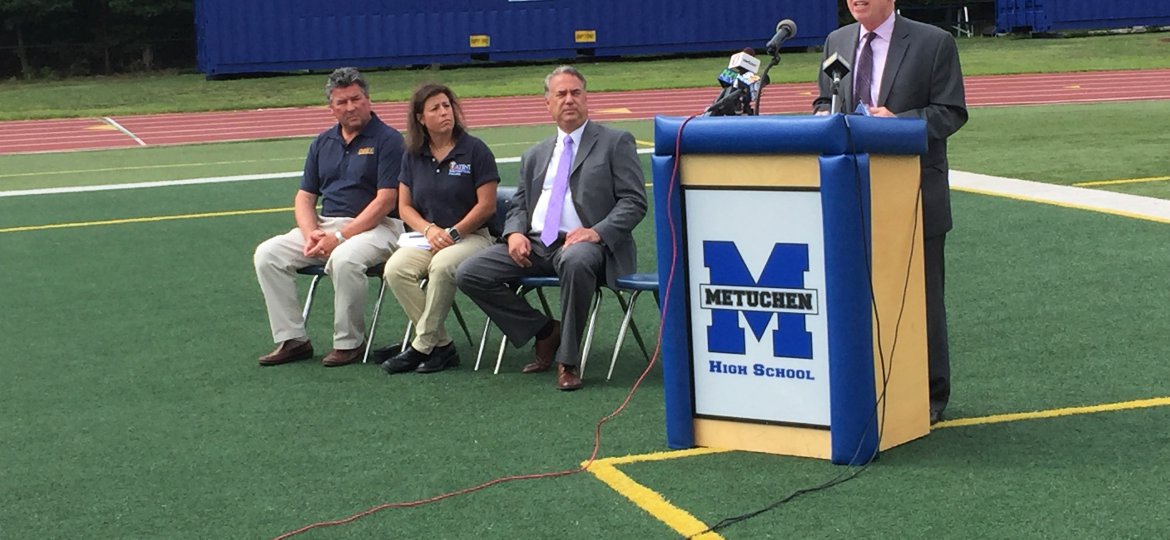
(Metuchen) – Senator Patrick J Diegnan Jr. alongside representatives of the Athletic Trainers’ Society of New Jersey (ATSNJ), New Jersey State Interscholastic Athletic Association (NJSIAA), and JFK Medical Center held a press conference today at Metuchen High School football field to inform parents and student-athletes on how to minimize the risk of heat stroke in high school athletics and to prepare coaches and athletic directors on the proper protocols for practice in the summer during extreme heat. Many fall sports programs at New Jersey high schools begin pre-season training in August, meaning that student-athletes will be practicing outdoors in very high temperatures.
“I am committed to raising awareness of exertional heatstroke and ensuring that parents, coaches, athletic trainers and others are prepared with heat illness emergency action plans and respond to symptoms in a proactive manner,” said Senator Diegnan (D-Middlesex). “Heatstroke in student-athletes is completely preventable and while New Jersey is at the forefront of athletic training for our high school athletes, we must continue to refine our best practices to ensure we avoid future tragedies while allowing our children the simple joy of competition in sports.”
Exertional Heatstroke (EHS) is the leading cause of preventable death in high school athletics and EHS ranks as the third leading cause of sudden death in high school athletes. Students participating in high-intensity, long-duration or repeated same-day sports practices and training activities during the summer months or other hot-weather days are at greatest risk.
“Exertional heat stroke is non-discriminatory. It can occur across different sports, to both boys and girls, from the varsity to freshman teams, and as people may not know between in-door and outdoor sports. In 2011, New Jersey was the first state to adopt the NATA preseason heat acclimatization guidelines for secondary school athletics,” said David Csillan, Athletic Trainer, Ewing High School and Co-Author, NATA Preseason Heat Acclimatization Guidelines for Secondary School Athletics. “Those states choosing to follow the guidelines have reported ZERO heat-related deaths in athletics and have always been ahead of the curve with regard to athletic health care and Senator Diegnan should be applauded for helping to maintain that standard.”
Football has received the most attention because of the number and severity of exertional heat illnesses. Notably, the National Center for Catastrophic Sports Injury Research reports that 35 high school football players died of EHS between 1995 and 2010. EHS also results in thousands of emergency room visits and hospitalizations throughout the nation each year. However, speakers cautioned that EHS is not limited to just football players and all players across all sports should be prepared for heat acclimation during the next couple of weeks of practice.
“Heat acclimatization policy has successfully modified how teams approach the fall pre-season practice regimen. There has been no reported fatality from exertional heat stroke in states where the heat acclimatization policy was mandated and abided by. The use of wet bulb globe temperature, or WBGT, to guide activity modification in the heat has started as far back as in the 1950s, and it is currently the standard procedure for the collegiate and professional level athletics,” said Yuri Hosokawa, PhD, LAT, ATC Korey Stringer Institute, University of Connecticut. “It is no doubt the secondary school athletes are as vulnerable, if not more, to heat stress, especially during the fall pre-season when they are re-introduced to physical activity in the heat. It is vital that secondary school athletics follow the heat acclimatization and WBGT guidelines to ensure the same standard of care in the youth level.”
Christina M. Emrich, an Athletic Trainer from Red Bank Regional High School and President of the Athletic Trainers’ Society of New Jersey demonstrated the use of the wet bulb globe temperature tool during the press conference. The WBGT registered a reading of higher than 92.1 on the football field, which under a situation if there was a high school sports practice scheduled would be delayed until later in the day when a cooler score would be measured.
“Every August JFK Emergency Services is called upon to treat an athlete who has been subject to excessive heat stress while practicing for high school athletics under conditions of high heat and humidity. JFK Medical Center is committed to working with Senator Diegnan’s office, and high school coaches and athletic trainers to prevent these unfortunate occurrences,” said Dr. Ken Herman, D.O., and Chief of Emergency Services at JFK Medical Center. “Coaches, trainers, parents and athletes should look for signs of heat illness such as muscle cramping, excessive sweating, fatigue, dizziness, pale skin, weak pulse, fainting, and confusion. Athletes themselves should be educated to hydrate before, during, and after training sessions, and athletes should be trained to maintain the color of their urine as light yellow to clear as a measure of hydration status. Treatment includes immediate transfer to a cooler environment, wetting the skin, and creating air flow to facilitate evaporation. Should symptoms persist, or be more serious, transport to a Hospital Emergency Department for definitive treatment would be appropriate.”
Senator Diegnan encouraged parents of student athletes to review the Heat Acclimation Plan and Guidelines on the NJSIAA website and talk with their child’s coaches on what is their school’s heat illness emergency action plan. The link to the NJSIAA pre-season heat acclimation plan is: http://www.njsiaa.org/documents/pre-season-heat-acclimatization

